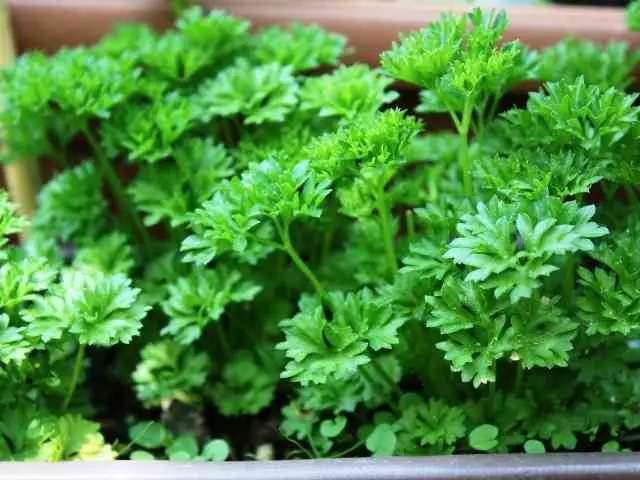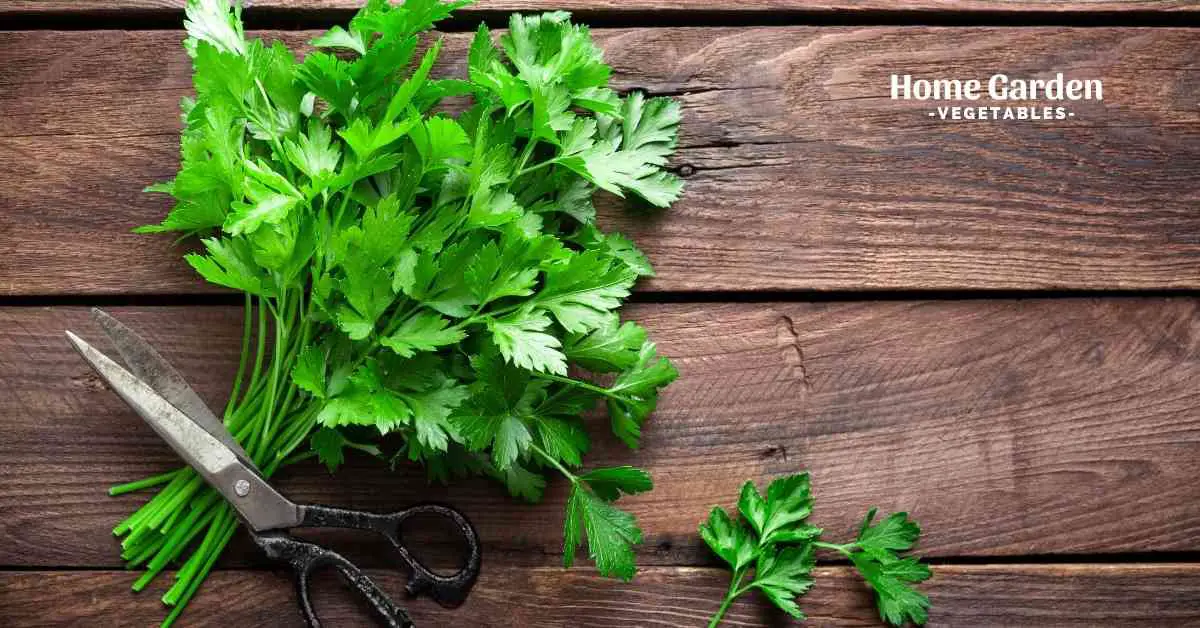I think you’ll agree with me when I say:
Parsley is like a fine old wine.
Reader Poll: What online courses would interest you?
It makes a good fit for preparing a tasty garnish on a fine night or an aromatic addition to countless recipes.
This annual culinary herb blends superbly with most cooked foods, and it is a significant source of calcium, iron, vitamin A & C.
You can start growing parsley in your backyards or indoors, in pots and containers, as soon as the risk of frost expires.
Subscribe to our newsletter!
The herb takes 14 to 30 days to germinate when the surrounding temperature falls between 65 to 75 degrees Fahrenheit.
No doubt the herb is fairly slow-growing, but trust me, it’s worth the wait and effort.
If you have not tried growing parsley yet, or you don’t know how long it takes to grow parsley in your gardens? Don’t worry; I am here to help you. By reading this article, you’ll be able to grow parsley with much ease.
How to plant parsley?

Best time to plant
Growing parsley through seeds is easy and fun.
You can start direct sowing parsley seeds in an outdoor location with plenty of sunlight or indoors, in pots or containers.
Plant the seeds in your backyard three to four weeks before the last estimated frost date in your area or indoors eight to ten weeks before the last frost date.
Opting for a suitable planting site
Parsley adores growing in sunny locations.
Therefore, it’s essential to opt for a spot that receives plenty of sunlight.
Concerning soil conditions, select a site that has rich soil with good water-draining properties.
You can fill your pots/containers with a commercial potting mix with high water-draining properties.
And one more thing, try to keep the opted planting site free of weeds and other vigorously growing plants to avoid over-crowding and competition for food and space.
Spacing, depth, and support
Parsley plants love their privacy. Therefore, it’s crucial to sow each seed at a proper distance from other seeds.
Try sowing seeds only about ¼ inch deep and maintain a distance of 6 to 10 inches apart.
Avoid sowing too many seeds in one spot. Intense seed sowing leads to overcrowding.
Because parsley takes a long time to germinate, make a note of where your seeds are so you don’t lose track of them. There will be no need for a support structure.
Growing parsley from seed: step-by-step
Growing parsley from seeds is a little tricky for novice growers. But, once you acquaint yourself with a few tricks, you’ll have better success.
Once you’ve decided to grow parsley from seeds, you’ve to show some patience.
Good things take time to show results.
Parsley types to grow from seeds
There are two major parsley types to grow: flat leaf and curly leaf.
Flat-leaf parsley, also known as Italian parsley, is full of flavour and cooks favourite. It has ornamental value and looks wonderful in pots and gardens.
On the other hand, curly leaf parsley is a little bitter for some tongues.
It’s totally up to you which type of parsley you want to grow.
The tricks of growing parsley from seeds are the same for both types.
Parsley seed shape
Look wise; parsley seeds are small and slender. They are weightless and look like fennel seeds.
Further, they’re oval and have a small arch to them. Parsley seeds are tan in hue and have vertical lines going through them.
Parsley seed growing methods
Concerning parsley growing methods, there are two: outdoors in patios or indoors in pots.
Whichever method you opt for will depend on where you are living.
If you’re living in climates with cold winters and spring, like me, growing parsley seeds indoors will give them enough time to mature. This will help you a lot in getting a better harvest.
In warmer climates, go for outdoor, direct seed sowing.
Best time to plant parsley seeds
You can sow parsley seeds directly into your garden 4-6 weeks before your typical last frost date or as soon as the soil can be worked in early spring because parsley seeds are cold-hardy and won’t be hurt by frost.
Plant them 6-8 weeks before your normal last frost date if you plan to start them inside.
Depending on where you live, the actual planting date will vary. For instance, because I live in zone 4b, I’d start my parsley seeds inside in March.
How to start parsley from seeds
As mentioned, starting parsley from seeds is a slow process. The parsley seeds can take 14 to 30 days to germinate.
But there is one thing that you can put into practice to ensure speedy germination and rapid growth: seed stratification.
Stratify your seeds by chilling them in your refrigerator for some time and soaking them in warm water for 12 to 24 hours.
Plating parsley seeds: step by step
The planting steps are the same whether you’re sowing seeds indoors or out. About direct sowing, you won’t need any equipment.
Supplies needed
- Seeds
- Water
- Pre-moistened seed starting soil, peat pellets, or rich potting soil
- Seedling flat with a lid
- Heat mat (optional)
Step 1: Fill up the trays.
If you’re about to start indoor parsley gardening, fill up your trays with good-quality potting soil.
Further, you can use seed pellets and put those into the trays.
Step 2: Know how many seeds to sow
It’s a great idea to seed 2-3 seeds per pit, cell, or pellet (either you’re growing them inside or outdoors) because they can be picky.
If you’re directly sowing the seeds in your garden, keep the clusters 6-8 inches apart.
Step 3: Sow the seeds
Because they’re so delicate, try to plant them approximately 1/4 inch deep.
I prefer to put the seeds on top of the ground and gently squeeze them down to the desired depth to make sowing simpler.
Step 4: Shield the seeds
Apply a small layer of soil to the seeds and gently press it down.
Precisely enough so that the topsoil comes into contact with the seeds, but not too much.
Step 5: Water the soil
To avoid dislocating the tiny seeds, water your seeds with a moderate spray from your yard hose or by splashing water into the matrices indoors.
Step 6: Enfold the seedling tray
Because you’re starting parsley seeds inside, preserve the soil moist and warm by covering each container with a plastic lid.
Parsley care

Sunlight
Sunlight plays a vital role in the germination and growth of parsley. Through sunlight, plants prepare their food.
Parsley is a sun-loving species. Therefore, opt for a space that receives at least six to eight hours of sunlight daily. Though, it prefers some afternoon shade from the blazing sun in hot climates.
Soil
Fill your pots with rich potting soil.
Rich soil promotes better germination and overall growth.
Loamy soil helps you prevent water lodging that could occur in an event of over-watering.
And one more thing: make sure the soil is slightly acidic to pH neutral.
Water
Parsley herb loves drinking lots of water daily.
Keep your plants properly watered by watering the soil evenly.
Add 1 to 2 inches of water per week.
Avoid under-watering. It makes the herb go under stress and perform poorly.
Periodically check the soil for water content by inserting your index finger. If the top 2 inches of soil feels dry, add water.
Temperature
Parsley can tolerate a range of temperatures, but it thrives at temps about 50 and 70 ℉. Germination requires a surface temperature of roughly 70 ℉. Parsley does not require any special humidity.
Fertilizer
Parsley can thrive from fun-size fertilization once or twice at the start of the growing season. However, it is not entirely necessary for its success.
Choose a balanced organic liquid fertilizer diluted to half-strength once a month in the spring to treat plants; make sure to use something suited for eating plants.
Furthermore, you can improve the nutrition of your soil by adding a lot of organic matter and compost.

